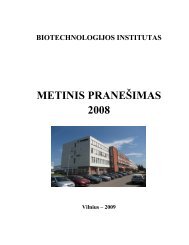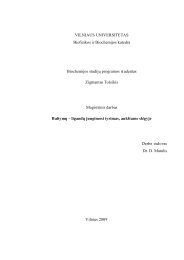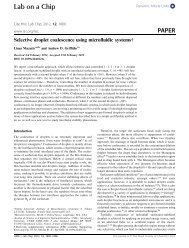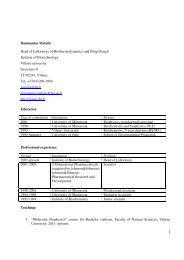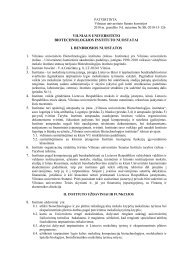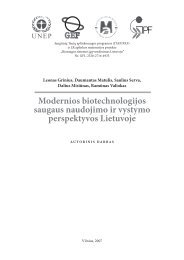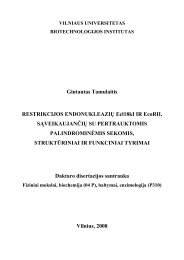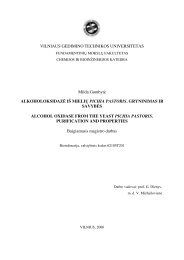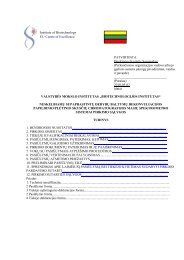Report 2008-2010
Report 2008-2010
Report 2008-2010
Create successful ePaper yourself
Turn your PDF publications into a flip-book with our unique Google optimized e-Paper software.
Master student V.Žilaitytė, Dr. A.Žvirbliene, junior scientist I.Šėžaitė, PhD student<br />
I.Kučinskaitė-Kodzė, junior scientist R.Lasickiene develop new hybridoma cell lines<br />
Junior scientist E.Jakubauskienė and PhD student I.Pečiulienė investigate HIF-3a<br />
expression<br />
Generation of monoclonal antibodies of desired specificity using<br />
chimeric virus-like particles<br />
Protein engineering provides an opportunity to generate new immunogens<br />
with desired features. Viral structural proteins with their intrinsic<br />
capacity to self–assemble to highly-organized virus-like particles<br />
(VLPs) have been shown to possess high immunogenicity and have<br />
been exploited as potential vaccines. Previous studies demonstrated<br />
that insertions/fusions of foreign protein segments at certain sites of<br />
VLP carriers did not influence protein folding and assembly of chimeric<br />
VLPs.<br />
In the Laboratory of Eukaryote Gene Engineering, chimeric VLPs representing<br />
major capsid protein VP1 of hamster polyomavirus (HaPyV)<br />
with inserted foreign sequences at certain surface-exposed regions<br />
were expressed in yeast S.cerevisiae. These chimeric HaPyV-VP1 VLPs<br />
have been shown to induce a strong antibody response against the<br />
inserts (Gedvilaite et al., 2004, Zvirbliene et al., 2006). Chimeric VLPs<br />
efficiently activate both B cells recognizing the surface-located epitopes<br />
and T helper cells providing the necessary signals for Ig class<br />
switching and affinity maturation.<br />
We have employed chimeric VLPs harbouring foreign sequences of<br />
different size and origin to generate insert-specific MAbs. The length<br />
of inserts ranged from 6 to 280 amino acids. It was demonstrated that<br />
chimeric VLPs efficiently stimulated the production of IgG antibodies<br />
specific for the sequences/epitopes presented at surface-exposed regions.<br />
This approach was successfully used to generate MAbs against<br />
non-immunogenic protein sequences, such as tumor-associated epitopes<br />
(Dorn et al., Viral Immunol, <strong>2008</strong>). Moreover, it was demonstrated<br />
that the insert-specific antibodies recognized native full-length<br />
proteins, which suggested the correct folding of the sequences displayed<br />
on VLPs. Our data confirm that the insertion of non-immunogenic<br />
epitopes into VLPs significantly increases their ability to<br />
induce a strong B cell response. Thus, chimeric VLPs represent highly<br />
efficient immunogens for hybridoma technology and provide a promising<br />
alternative to chemical coupling of synthetic peptides to carrier<br />
proteins.<br />
This work was supported by UAB Fermentas (Contract No. 1224).<br />
Regulation of hypoxia-inducible factor HIF-3α expression via the<br />
alternative pre-mRNA splicing mechanism.<br />
Recent genome-wide analyses of alternative splicing indicate that up<br />
to 70% of human genes may have alternative splice forms, suggesting<br />
that alternative splicing together with various posttranslational modifications<br />
plays a major role in the production of proteome complexity.<br />
Changes in splice-site selection have been observed in various types of<br />
cancer and may affect genes implicated in tumor progression and in<br />
susceptibility to cancer. This may lead to altered efficiency of splice-site<br />
recognition, resulting in overexpression or down-regulation of certain<br />
splice variants, a switch in splice-site usage, or failure to recognize splice<br />
sites correctly, resulting in cancer-specific splice forms. At least in some<br />
cases, changes in splicing have been shown to play a functionally significant<br />
role in tumorigenesis, either by inactivating tumor suppressors<br />
or by gain of function of proteins promoting tumor development.<br />
Thus, the identification of cancer specific splice forms provides a novel<br />
source for the discovery of diagnostic or prognostic biomarkers and<br />
tumor antigens suitable as targets for therapeutic intervention.<br />
Figure 3. Schematic representation of HIFα subunit mRNA variants detected in<br />
the cell.<br />
35 th anniversary<br />
38



